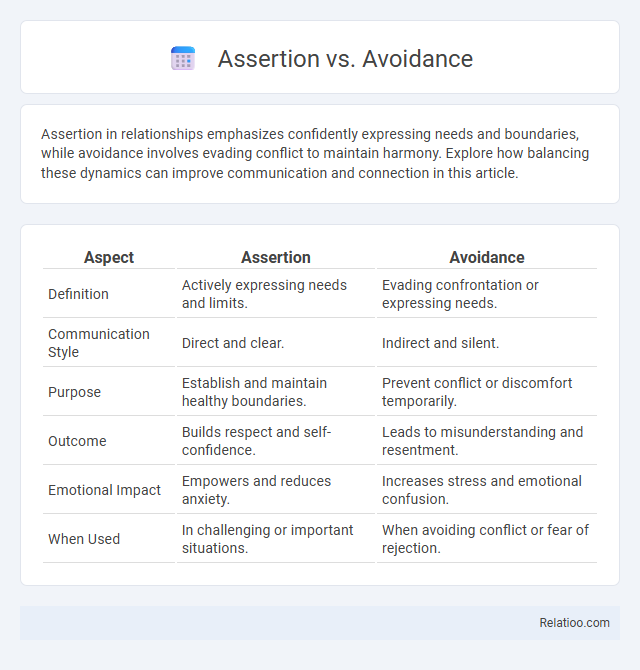Assertion in relationships emphasizes confidently expressing needs and boundaries, while avoidance involves evading conflict to maintain harmony. Explore how balancing these dynamics can improve communication and connection in this article.
Table of Comparison
| Aspect | Assertion | Avoidance |
|---|---|---|
| Definition | Actively expressing needs and limits. | Evading confrontation or expressing needs. |
| Communication Style | Direct and clear. | Indirect and silent. |
| Purpose | Establish and maintain healthy boundaries. | Prevent conflict or discomfort temporarily. |
| Outcome | Builds respect and self-confidence. | Leads to misunderstanding and resentment. |
| Emotional Impact | Empowers and reduces anxiety. | Increases stress and emotional confusion. |
| When Used | In challenging or important situations. | When avoiding conflict or fear of rejection. |
Understanding Assertion and Avoidance
Understanding assertion involves recognizing your right to express thoughts, feelings, and needs confidently and respectfully, while avoidance means steering clear of confrontation or difficult situations often to prevent discomfort or conflict. Your ability to assert effectively promotes healthy communication and self-respect, whereas avoidance may lead to unresolved issues and increased stress. Balancing these approaches requires awareness of when to stand firm and when to step back to maintain emotional well-being.
Key Differences Between Assertion and Avoidance
Assertion involves confidently expressing Your thoughts, feelings, and rights while respecting others, whereas avoidance entails evading conflicts or difficult conversations to prevent discomfort. Key differences lie in communication style: assertion promotes openness and problem-solving, while avoidance leads to silence and unresolved issues. Mastering assertion can improve interpersonal relationships and self-esteem by encouraging honest dialogue.
The Psychology Behind Assertive Behavior
The psychology behind assertive behavior centers on the balance between expressing one's needs and respecting others, differing significantly from avoidance, which involves evading conflict or uncomfortable situations, and aggression, which violates others' rights. Assertiveness enables effective communication by promoting self-confidence and emotional intelligence, fostering healthier interpersonal relationships, and reducing stress caused by unexpressed feelings or passive behavior. Psychological theories highlight that assertive individuals maintain clear boundaries while engaging empathetically, contrasting with avoidant behavior's passivity and aggressive behavior's domination.
Causes and Consequences of Avoidant Behavior
Avoidant behavior often stems from fear of rejection, low self-esteem, or past negative experiences, leading individuals to steer clear of conflicts or challenges. This avoidance can result in unresolved issues, increased anxiety, and weakened relationships due to unmet needs and suppressed emotions. By recognizing these causes, you can develop healthier coping strategies that foster assertiveness and improve communication.
Benefits of Practicing Assertion
Practicing assertion improves communication skills by enabling individuals to express their thoughts and needs clearly and confidently without aggression or passivity. This approach fosters healthier relationships and reduces misunderstandings by promoting honest and respectful dialogue. Increased self-esteem and decreased stress levels result from setting boundaries and standing up for personal rights effectively.
Drawbacks of Relying on Avoidance
Relying on avoidance as a communication strategy often leads to unresolved conflicts and increased stress, negatively impacting your mental health and relationships. Avoidance can cause important issues to fester, resulting in misunderstandings and diminished trust over time. This approach limits personal growth and problem-solving skills, hindering effective communication and emotional resilience.
Situations That Require Assertion vs. Avoidance
Situations that require assertion often involve defending Your rights or expressing Your needs clearly and confidently without aggression, such as negotiating a raise or setting personal boundaries. Avoidance is suitable in scenarios where the conflict is trivial, emotions are high, or the issue could escalate unnecessarily, like avoiding arguments over minor inconveniences. Knowing when to assert or avoid helps maintain respectful relationships and effective communication.
Common Misconceptions About Assertion and Avoidance
Common misconceptions about assertion and avoidance often confuse avoidance with passivity or weakness, while assertion is mistakenly seen as aggressive or confrontational. You can assert your needs and boundaries confidently without being hostile or disrespectful, promoting healthy communication and self-respect. Understanding that avoidance may involve protecting oneself from unnecessary conflict rather than simply dodging issues helps clarify these distinct responses.
Developing Assertive Communication Skills
Developing assertive communication skills empowers you to express your thoughts and feelings clearly while respecting others, balancing between assertion, avoidance, and passive-aggression. Mastering assertion involves confidently stating your needs without infringing on others' rights, contrasting with avoidance that can lead to unresolved conflicts and stress. Strengthening these skills enhances your interpersonal relationships, promotes mutual understanding, and supports emotional resilience in both personal and professional settings.
Choosing Between Assertion and Avoidance Effectively
Choosing between assertion and avoidance effectively depends on understanding the context and desired outcome of a situation. Assertion involves confidently expressing your needs and boundaries, which promotes self-respect and clear communication, while avoidance often prevents conflict but can lead to unresolved issues and stress. Your ability to evaluate situations and select assertion when facing constructive dialogue or avoidance when managing overwhelming stress ensures healthier interactions and emotional balance.

Infographic: Assertion vs Avoidance
 relatioo.com
relatioo.com